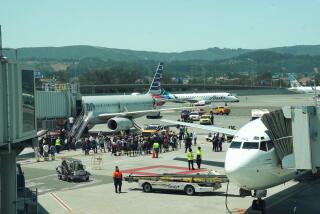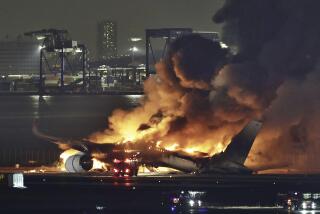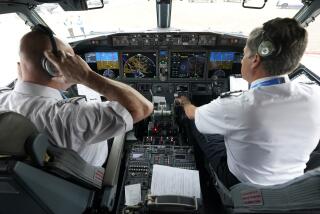FRIENDSHIP FLIGHT: Tony Circles the Globe : Peril Over D.C.: Smoke Fills Chase Plane’s Cabin
- Share via
WASHINGTON — The first sign of trouble came just moments after takeoff from National Airport about 12:40 p.m., when pilot Lance Allyn smelled smoke in the cockpit of his twin-engine airplane.
“Where’s the smoke coming from? I smell smoke,” Allyn inquired urgently as wisps of gray smoke began seeping from the instrument panel of his King Air, which was ferrying luggage and members of an entourage for boy aviator Tony Aliengena of San Juan Capistrano in his bid to become the youngest pilot to fly around the world.
Allyn and the five passengers in his plane, one of two chase planes following the 11-year-old flier, looked around frantically for the source of smoke, but they could not tell where it was originating. Sean Hardin, member of a film crew accompanying Tony, checked his video equipment to see if it was burning. He was riding in the co-pilot’s seat to shoot aerials for a documentary about the youth’s around-the-world flight.
Suddenly, at about 1,000 feet above the Potomac River, clouds of smoke spewed from the instrument panel, engulfing the cockpit and forcing the four passengers seated in the pressurized cabin to clutch clothing to their mouths to help them breathe.
Hardin grabbed a teddy bear that Allyn keeps on his dash for good luck and pressed it to his mouth to filter out the smoke.
Both Hardin and Allyn opened small windows on either side of the cockpit, but the smoke streamed out too fast for the cabin to clear.
The plane landed safely back at National Airport, and there were no serious injuries, although all passengers were treated for smoke inhalation. Tony, who experienced mechanical trouble of his own Saturday, was unaware of the difficulties with the second chase plane until he landed at Lawrence Airport outside Boston.
Passengers on Allyn’s King Air said they all feared the worst.
“We were basically thinking to ourselves, ‘We’re going to die,’ ” said Guy Murrel, 28, a public relations consultant from Costa Mesa who is coordinating Tony’s flight.
“I was saying the Lord’s Prayer,” added Sandy Herring, 36, a publicist from St. Louis who represents Hampton Inn, a nationwide hotel chain helping to sponsor the flight. “I was saying, ‘Please, God, don’t let it (dying) hurt.”
But disaster was averted by the pilot’s quick and calm handling of the crisis.
Allyn, pressing his face close to the open window to breathe, shut off the aircraft’s electrical system, reducing the outflow of smoke. He then radioed back to National Airport that he needed emergency clearance to land.
Although the air traffic controller directed him to nearby Andrews Air Force Base, smoke remained so dense that Allyn could not see the air base and was forced to turn around to National with emergency clearance. In so doing, he maneuvered his King Air through restricted airspace above the Capital’s monuments and government buildings.
Awaiting the plane were five fire engines from the Washington Airport Authority, positioned alongside the runway with emergency lights flashing. During the descent, smoke finally dissipated from the cabin, enabling the occupants to breathe freely. Allyn restarted the electrical system only long enough to lower his landing gear.
When Allyn guided the plane safely back off the runway, his passengers erupted into wild applause and crushed him with hugs.
“The guy’s a hero,” said Hardin, 27, of Los Angeles.
The passengers, who also included Tony’s Soviet pen pal, Roman Cheremnykh, 10, then embraced one another like close family. And on the ground, Roman smiled, seeming calm, but he asked to “call Moscow” to speak with his relatives.
“Life! Life! Thank God!” said Herring, who boarded Allyn’s plane in St. Louis and was to remain aboard only as far as Saturday’s leg to Boston.
Allyn, 46, an orthopedic surgeon from Hanford in the San Joaquin Valley, and his passengers were treated at the scene by paramedics for smoke inhalation. Hardin and this reporter were administered a small amount of oxygen to overcome mild dizziness.
Only Allyn, a veteran pilot who has flown his King Air for 10 years, appeared unshaken afterward. When asked about his calm demeanor in the plane, Allyn just smiled and said, “I was too busy to be nervous.”
He added that this was the first time he had experienced a smoke problem in the plane, which was manufactured in 1966. The exact problem had not been diagnosed late Saturday, although mechanics suspected a failed clutch gear.
Gary Trageser, a business jet pilot at National Airport’s Butler Aviation, where Allyn’s plane was towed for repair, said that smoke in the cockpit generally affects only the electrical system--not the engines that power the aircraft. But he said the smoke was still extremely dangerous.
“The biggest problem,” Trageser said, “is becoming overcome by smoke.”
More to Read
Sign up for Essential California
The most important California stories and recommendations in your inbox every morning.
You may occasionally receive promotional content from the Los Angeles Times.













